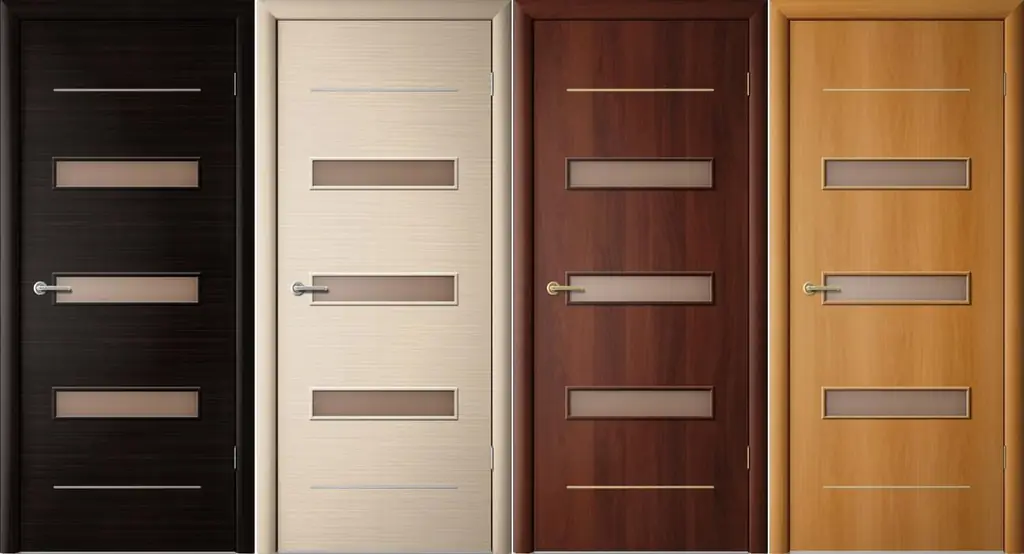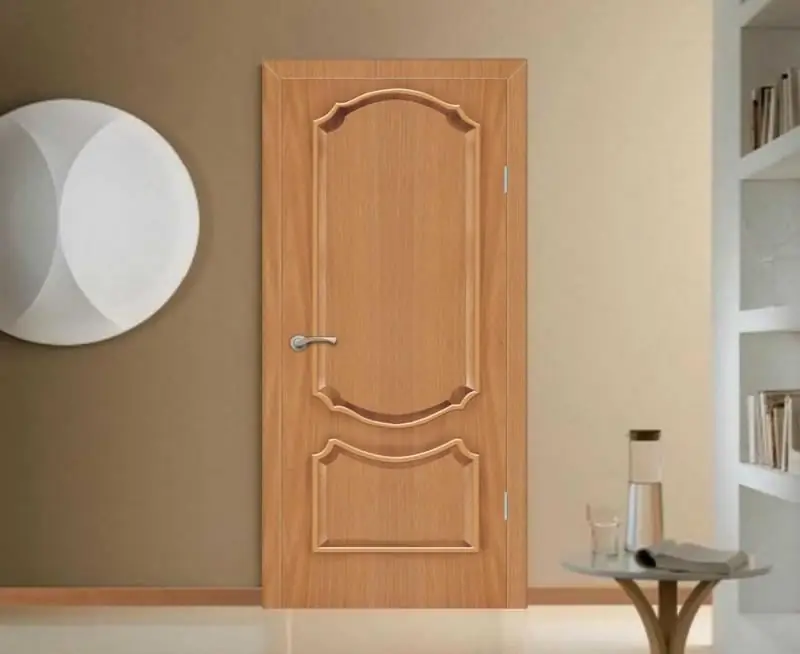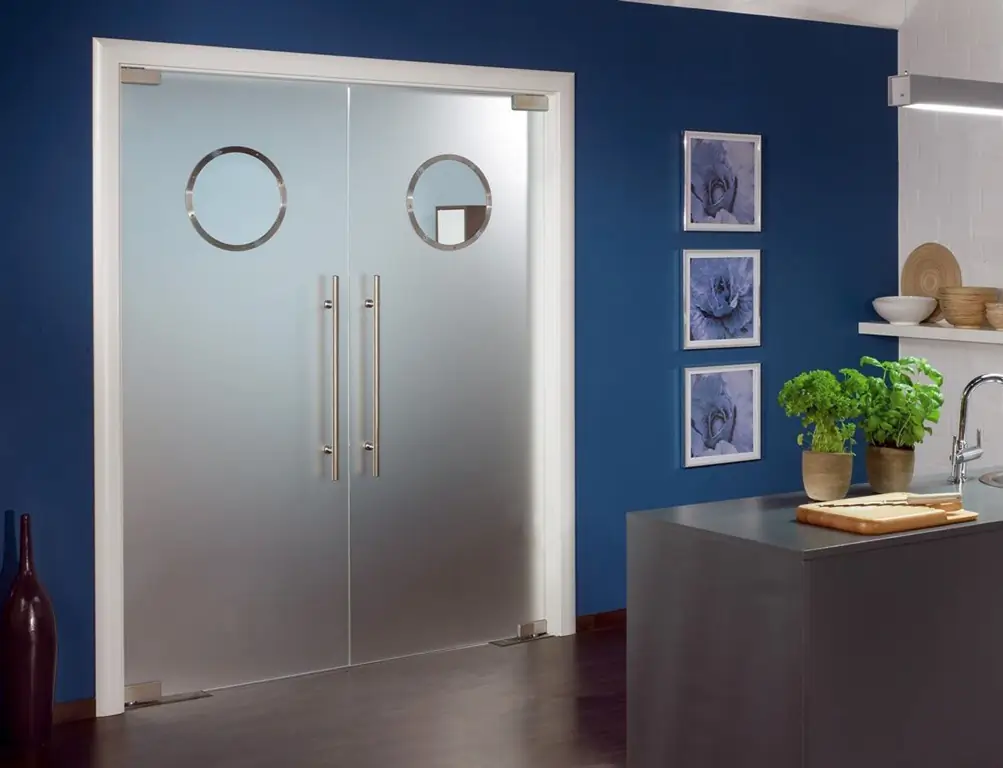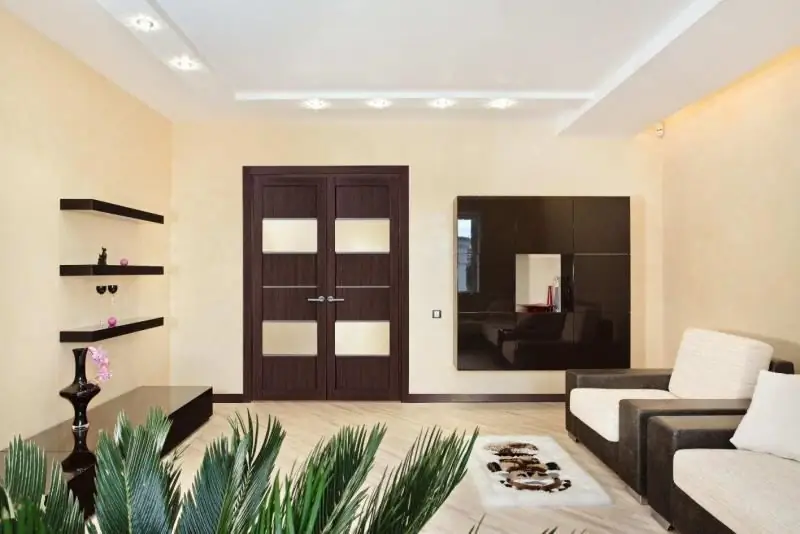
Table of contents:
- Author Bailey Albertson [email protected].
- Public 2024-01-17 22:26.
- Last modified 2025-01-23 12:41.
Laminated doors: types and features

Installation of laminated doors is a modern solution for arranging residential, office or utility rooms. The designs of such doors are varied, and each option has certain features that should be considered when choosing.
Content
-
1 What are laminated doors
1.1 Features of the device of the laminated door
-
2 Types of laminated doors
-
2.1 Classification by type of door leaf
- 2.1.1 Fixed laminated doors
- 2.1.2 Glazed laminated doors
-
2.2 Types of doors by material
- 2.2.1 Laminated MDF doors
- 2.2.2 Plastic laminated doors
- 2.2.3 Laminated chipboard doors
-
- 3 Popular colors of laminated doors
-
4 Features of installation and operation of doors
- 4.1 Basic steps of door installation
- 4.2 Video: wizard tips for installing doors
-
4.3 How to repair laminated doors
4.3.1 Video: Removing scratches with a furniture stroke
- 4.4 How to care for laminated doors
- 5 User reviews and opinions
- 6 Photo gallery: laminated doors in the interior
What are laminated doors
In the process of repairing residential or office premises, it is often necessary to replace the door frame and leaf. Among the variety of doors, laminated models are especially in demand. They can have a different internal structure, but the outside is always decorated with a laminated film. Thus, the color of the doors can be any, but patterns imitating the structure of wood of different species are popular.

The inner filler of laminated doors can be different, but outside they are always decorated with a laminated film
Laminated doors have a frame that is often made from natural softwood. Also chipboard (chipboard) can serve as a material for the frame, but this option is typical for the cheapest doors. The inner filler can be made of extruded polystyrene foam or corrugated board, and the outer layer can be made of MDF (Medium Density Fiberboard) and laminated film. Thus, laminated doors are composed of several different materials that create a beautiful and durable door leaf.
Features of the device of the laminated door
The frame with the filling, as well as the MDF layer and the laminated film form the door leaf. The combination of natural and synthetic materials makes the product durable, practical and reliable. The design of laminated doors has the following important features:
- MDF is covered with a thin film - a laminate, which is fixed by hot pressing during production. The ends of the finished products are decorated with a special edge tape, which gives the door a complete look and protects the canvas from moisture and deformation;
- honeycomb filler made of extruded polystyrene foam or corrugated board provides sound and heat insulation. Therefore, laminated doors are practical to use and comfortable for living quarters. Due to the honeycomb structure, such doors weigh much less than models made of natural wood;
- the door frame has a locking part where the lock and the door handle are installed. This area has a more reinforced frame than the rest of the web;
-
the film protects the structure from deformation and gives the product an aesthetic appearance. For laminated doors, coating options such as:
- two-chrome laminate;
- polyvinyl chloride film (PVC);
- multilayer impregnated paper;
- film on paper base 0.2 mm thick.

Laminated doors differ from veneered doors only by the outer coating
The main difference between laminated structures and veneered ones, which are another popular option, lies in the type of external coating used. Laminate film is a colored coating on a PVC or paper base, and veneer is a thin layer of wood covered with a colored layer and various protective compounds.
Types of laminated doors
When choosing a laminated door, it is best to focus on the following product characteristics:
- The type of laminated coating: the service life, resistance to mechanical stress and moisture, the appearance of the door depend on it.
- Construction design: it should match the overall design of the environment, and the color palette should match the tone in which the room is decorated.
- Thickness, width and height of the door: the dimensions are determined depending on the parameters of the opening in which the structure will be installed, taking into account the frame.
- Defects: blisters, cracks and other damage should not be present on the surface of the product.

Correctly chosen laminated door will serve for many years without repair
Classification by type of door leaf
By the type of door leaf, laminated doors can be divided into 2 types: solid and glazed.
Blind laminated doors
Blind-type doors are a canvas without glass inserts, carved and figured elements. Often such products are presented in the form of a flat canvas, but they can also have simple decorative elements. Deaf laminated doors look laconic and strict, and a smooth surface can have a light relief that imitates the structure of wood.

Deaf laminated doors will easily fit into any interior
Deaf laminated doors are characterized by higher sound insulation than models with glass inserts. Smooth or slightly embossed surface makes the door universal for any interior style. The parameters of blind doors can be different, which allows you to choose a design for any opening. Products most often have a rectangular shape, but there are also arched versions.

Doors with laminated film can be of any color
Positive sides of blind doors:
- increased strength compared to structures with inserts;
- high sound insulation;
- a higher level of reliability and durability than products with glass;
- laconic and austere design.

Laconic doors are practical and comfortable for living spaces
A negative feature of blind canvases is that scratches, cracks and other damage are more visible on them. This leads to the need to repair or even replace the door.
Glazed laminated doors
Glazed doors are products consisting of a frame and glass. The shape of glass inserts can be rectangular or curly.

Glass inserts can have both a decorative and a practical function: for example, letting in light from a room into a dark corridor
Most often, glazing in doors is used exclusively for decorative purposes. But glass in a door leaf can also play a practical role: a transparent insert is used as a source of additional lighting in a room without windows. Laminated glass doors are suitable for almost any setting. They unite space, create the illusion of lightness and airiness.

Glass inserts in interior doors add lightness to the interior
Glass in a laminated door can be:
- transparent;
- matte;
- corrugated;
- colored;
- with an image.

For decoration, you can use a film stained glass window, which will not only decorate the door leaf, but also make the glass more durable
The disadvantages of glazed laminated doors are low thermal insulation characteristics and poor sound insulation.
Door types by material
There are several types of laminated doors, which differ in the material used in the manufacture of the product. Each variety has certain characteristics.
Laminated MDF doors
The structure of the door made of MDF has a classic structure, which implies the presence of a frame, filler, and outer leaf. A distinctive feature of such a door is that the outer sheet is made of slabs, which are thick cardboard of a coarse fraction. This material is obtained by pressing at a high temperature and the use of an adhesive composition. Outside, the canvases are covered with a film, which can be PVC or paper based.

MDF is a rough and thick cardboard covered with a film
MDF doors are lightweight and low cost. This makes them a budget option, but it is worth considering the low resistance of the material to moisture, mechanical stress and active use. The color palette is very extensive, since there are many options for films that cover the outer MDF canvas.

MDF can be covered with a smooth or matte film, as well as a corrugated film that imitates the surface of natural wood
Lightweight and comfortable MDF structures have the following advantages:
- simple care that does not require the use of special cleaning agents;
- easy installation and assembly of the structure directly at the installation site;
- wide palette of shades, pleasant to the touch surface structure;
- light weight, the ability to install any locks and door handles.

Laminated doors can be decorated in a variety of styles, such as the Rococo style, which is characterized by an abundance of gold details and pastel colors
When purchasing high-quality MDF doors, it should be borne in mind that paper-based film, which is a common option, is not very durable. Under conditions of normal humidity in the room, as well as careful use and proper care, such doors will last more than 10 years. Otherwise, there is a high probability of peeling of the film, swelling of the door, deformation of the box and the canvas.
Plastic laminated doors
Laminated doors covered with PVC film are called plastic doors and can have glass inserts, different decor or other design. They can be sliding, double-leaf, classic swing or arched. Manufacturers also produce doors in the form of an accordion or a book and other options.

The design of plastic laminated doors is more varied than other door options
The main characteristic of plastic laminated doors is a higher strength of the coating, since the film is made of PVC. Diverse color palette, many design options make it easy to choose a product for any room. The service life of plastic laminated doors is also higher than that of paper coated models.
Chipboard laminated doors
Particleboard (chipboard) is often the basis for the manufacture of laminated doors. Such material is made from wood chips with the addition of binders, water-repellent and other components. Thanks to the use of large chips, chipboard has a pronounced structure and has higher technical characteristics than MDF.

Experts say that chipboard is more durable than MDF
The main feature of chipboard is expressed in high strength, which makes the structures durable and reliable. The content in the structure of antipyrine, water-repellent, powerful binding components ensures the resistance of the material to moisture, temperature extremes and active operation.

Externally, doors made of chipboard differ little from products made of MDF
Chipboard boards covered with a laminated film are called chipboard. This material serves as the basis for the outer door covering. Due to its strength and other characteristics, chipboard has such advantages as:
- resistance to shocks, cracks, scratches;
- a variety of shapes and colors of doors;
- affordable price.

Doors and furniture made of laminated chipboard go well with each other
Despite the strength, the doors made of chipboard are not sufficiently resistant to high humidity. With constant exposure to water, the material can deform, swell, then the doors will lose their beautiful appearance and will be inconvenient to use.
Popular colors of laminated doors
Thanks to the use of various films, laminated doors can be of any color. Classic shades are wenge, milk oak, milanese walnut and beech. The shade names reflect the natural wood color for which the imitation was created. Common colors are also relevant, for example, classic white, black, burgundy and other options.

Depending on the manufacturer, the exact names of the shades of the laminated film may vary.
Features of installation and operation of doors
Laminated doors can be made to order from the manufacturer or purchased from a store. In the first case, the product meets the individual requirements of the customer as much as possible, and in the second, you need to carefully choose the doors depending on the characteristics of the room, design, personal preferences. But whatever the choice - in any case, you can install the structure yourself.
For work, you will need screws 3.5x25, 3.5x65, 4.2x90, 3.5x51. Of the tools you need a tape measure, a building level, a square, a screwdriver, polyurethane foam in a gun.
The main stages of door installation
-
The doorway is prepared by removing the old door. Then you should align the edges of the door slopes.

Opening preparation for door installation The old opening must match the dimensions of the new door frame
-
After that, the door frame is assembled, the hinges are cut in and the resulting structure is installed in the opening.

Door installation diagram Above and below from the edge of the door to the hinges, you need to retreat about 20 cm
-
Next, hang the canvas on the hinges, check the flatness with a square and, if necessary, adjust it with a rubber hammer by slightly displacing the box or door. After that, the cracks between the wall and the box are treated with polyurethane foam, the door lock is cut in, additional elements and cashing are mounted.

Installation of interior doors After drying, pieces of polyurethane foam are cut flush with the wall
Video: wizard tips for installing doors
How to repair laminated doors
Laminated doors in residential or office buildings are subject to heavy use and breakage. In most cases, experts recommend replacing old structures with new ones, but sometimes you can repair or even restore doors yourself. This is possible in the following common situations:
- small holes, scratches, cracks in the coating can be easily fixed with furniture wax and a special furniture marker. The color is selected depending on the shade of the door, the scratches are carefully painted over, hiding their presence;
- the peeled edge must be carefully removed, a new edge tape must be purchased in the same color as the old one and attached to the place of the peeled one, smoothing with a hot iron;
- if the door sags, then you need to tighten the screws of the hinges, adjusting the desired height;
- if a door lock or handle breaks down, they must be replaced with new ones, carefully removing the old ones.

Scratches are easy to paint over with a furniture marker
If the main part of the door leaf is swollen and covered with bubbles, then it is impossible to repair such a structure. Similar consequences occur due to high humidity. Peeling of the paper film on the main canvas can be corrected by applying PVA glue to the damaged area with a brush, but this measure is only temporary, and the door will still need to be replaced.
Video: Removing scratches with a furniture stroke
How to care for laminated doors
Doors of this type are budgetary and do not have a very long service life compared to natural wood structures. The service life can be extended only by observing simple rules for caring for the products.
- Water is the main enemy of laminated doors. You cannot wash the canvas with a wet rag or sponge, you need to use polish, wax and other cleaning agents intended for furniture.
- The film does not withstand strong impacts and therefore careful handling is important.
- If you do not fix the canvas, which touches the box when closed, the edge tape may peel off, and other defects will appear.
- Do not rub the surface with hard, metal, coarse sponges, as visible scratches will immediately appear on the film.
- For installation in rooms with high humidity (bathroom, toilet, kitchen), it is best to choose wooden doors or high quality laminated chipboard structures.
- Squeaking hinges should be lubricated with special agents, for example, WD-40 universal grease, and the application of such agents should be pointwise.

Apply the hinge grease carefully so that it does not get onto the laminated surface.
User reviews and opinions
Photo gallery: laminated doors in the interior
-

Laminated doors in the living room interior - Glass doors are optimal for a living room in any style
-

Bright environment in a residential building - Beige designs look fresh and beautiful in light-colored interiors
-

Double doors in a spacious living room - Curly glass inserts decorate doors and emphasize the style of the interior
-

White interior doors in the house - Laconic white doors are universal and are not a bright detail of the decor
-

Blind bedroom door - Blind doors are suitable for the bedroom: they provide silence
-

Door with a small glass insert - Small frosted glass inserts - a trendy option for bathroom doors
-

The combination of different doors in the interior of the corridor - Frosted glass makes the door original, but the blind door does not allow heat, noise and light to pass through
For installation in a home, office or apartment, it is easy to choose budget and high-quality laminated doors. Correct care and correct installation of the product will be the key to the durability of the structure.
Recommended:
Interior Glossy Doors And Their Varieties, Advantages And Disadvantages, As Well As Use And Compatibility In The Interior

Glossy doors: production and types. The use of doors with a glossy surface in the interior. Reviews
Double-leaf Doors: Entrance And Interior Doors, As Well As Their Varieties With A Description Of The Device And Installation

Double-leaf doors: types, standard sizes. Accessories for double doors. Installation stages and operation features. Reviews
MDF Doors: Entrance And Interior Doors, Their Varieties With A Description And Characteristics, Advantages And Disadvantages, As Well As Installation And Operation Features

Doors from MDF: features, characteristics, varieties. Making and installing MDF doors with your own hands. Door restoration. Reviews, photos, videos
Doors For Restaurants, Bars And Cafes And Their Varieties With A Description And Characteristics, As Well As Features Of The Device And Operation

Features of types of doors for bars and restaurants. Selection and installation of structures, as well as rules for caring for doors in public areas
Wenge Interior Doors And Their Varieties With A Description And Characteristics, As Well As Options For Combinations Of Shades In The Interior

How to choose the right material for a wenge door. Why is it easy to choose the perfect floor for a wenge-colored door. What styles and tones is wenge friendly with
